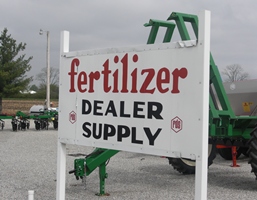The USDA is projecting the number of turkeys raised in the U.S. this year at 214 million head,...
Fertilizer Prices Likely to Ease This Year

Farmers are set to reap the benefits of declining fertilizer prices as they plant their crops this spring. Geopolitical and supply chain challenges eroded some of their profit last year.
The Green Markets Weekly North America Fertilizer Price Index fell 3.3% last week. NOLA Urea dropped $20, DAP declined $5, and Corn Belt potash was flat.
Josh Linville, Vice President of Fertilizer at StoneX Financial Services, says the outlook for nitrogen has improved in the last 12 months. “From a U.S perspective, urea is the best priced nitrogen source. UAN (urea and ammonium nitrate) and NH3 (Anhydrous ammonia) are both higher than typical premiums vs. urea, and we see a lot of signs that farmers are switching to lock in the savings,” Linville says. “If that happens on a large scale, it could put the U.S./Canada supply and demand out of balance, which will also have price implications.”
GLOBAL FACTORS
Domestic fertilizer production represents only 7% of global production, and geopolitical events thousands of miles away affect prices at home.
Center to the soaring prices of nitrogen last year was the European natural gas production rates as gas prices dictate the cost of ammonia and nitrogen. High natural gas production cost turned off almost all production there. For example, in August, Dutch TTF, a virtual trading point for pricing natural gas and the overall European LNG import market, reached $103 and “looked as though they would remain there for a long time with winter coming,” Linville says. But the tide has turned partially because of a warmer winter. Today, the Dutch TTF is in the $14 range.
Moreover, the Russian invasion of Ukraine a year ago sent nitrogen prices spiraling, as Russia provides 20% of global fertilizer supplies. Belarus’s potash exports account for 20% of the global supplies. The perception at that time was exports will almost come to a halt because of Western economic sanctions on both countries. However, a global outcry about food security led to a change in policy. Eventually, Russian-maintained business relations with non-Western nations and the nitrogen exports remained almost unchanged.
The third biggest focus point has been on China’s urea exports. In the fall of 2021, China banned urea exports. “Many believed that would continue going forward. While exports were down significantly overall in 2022, there are signs of their coming back,” Linville says.
Potash values, on the other hand, have been on a near continuous slide since last March/April as farmers made applications cuts to defend against historic high prices, according to Linville. “While current values are still high vs. history, they match up very well against current grain values, which could mean demand is higher than anticipated,” Linville says.
Tampa ammonia, the world’s benchmark, has plummeted to pre-war level this year as production costs declined.
Middle East ammonia was down 27% but still “trading above normal nutrient spread to Middle East urea, suggesting further price declines,” according to Bloomberg’s Green Markets’ March 13 report.
“Ultimately, there are still several global factors that will play a large part in how much values go up or down moving forward,” Linville says. “It is hard to bet against a near year-long priced slide trend, but eventually bear markets turn around.”
EDITOR’S TAKE:
Lower fertilizer prices will be welcome news for farmers/ranchers heading into planting and hay season. As the article states, farmers/ranchers were hit hard by rapidly increasing fertilizer prices in 2022. Those higher prices impacted their profit margins for the year. It appears that the lower fertilizer prices in 2023 will once again help them improve profitability. It at least sets the stage for the opportunity to have another very good net income at year’s end. That extra money will flow to their bottom line and help improve your chances of selling them more trucks. Now is a good time to start letting them know about your inventory by putting it on AgTruckTrader.com.








-1.jpg?height=200&name=wheat%20-%20harvest%20w%20multiple%20JD%20combines%20(2)-1.jpg)